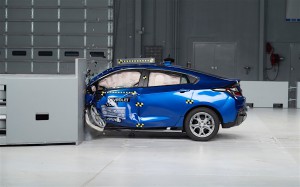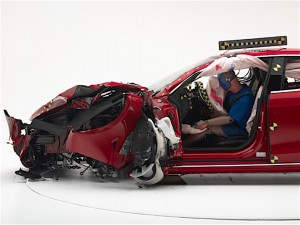
The 2017 Chevy Volt earned the IIHS's Top Safety Pick Plus award along with the 2017 Toyota Prius Prime.
It appears that great gas mileage – or no gas mileage at all – and safety can go hand-in-hand, according to the latest Insurance Institute for Highway Safety testing results.
The group recently gave the Chevy Volt and Toyota Prius Prime its top scores, Top Safety Pick Plus, to the two plug in hybrids. It also took the time to rate the Tesla Model S and BMW i3 all-electric vehicles and noted that those fell just short of earning that “Plus” distinction.
“There’s no reason the most efficient vehicles can’t also be among the safest,” says David Zuby, IIHS executive vice president and chief research officer. The Prius Prime is the more miserly of the two getting 54 mpg while the Volt came in at 42 mpg.
Conversely, the Volt can go longer in electric-only mode at 53 miles while the Prius tops out at 25 miles.
To qualify for the 2017 Top Safety Pick award, a vehicle must earn good ratings in all five crashworthiness evaluations — small overlap front, moderate overlap front, side, roof strength and head restraints — and come with a front crash prevention system that earns an advanced or superior rating.
(What new models top the list, according to the annual Car Book? Click Here to find out.)

The Tesla Model S fell just short of "Plus" status due to is poor headlights and results on the overlap test.
The “plus” is awarded to vehicles that meet all those criteria and also come with good or acceptable headlights, which is what hampered the two EVs in testing.
“We hope Tesla and BMW will continue to refine the designs of their electric models to maximize driver protection and, especially in the case of Tesla, improve their headlights,” Zuby said, adding IIHS plans to test Chevrolet’s new EV, the Bolt, later this year.
The Model S, a large luxury sedan, earns good ratings in all IIHS crashworthiness evaluations except the challenging small overlap front crash test, in which it earns an acceptable rating. Despite lengthening the side curtain airbags to improve small overlap protection in the Model S, Tesla ran into problems in the test when the safety belt allowed the dummy’s torso to move too far forward.
That allowed the dummy’s head to hit the steering wheel hard through the airbag. Measurements from the dummy indicated that injuries to the head, along with the lower right leg, would be possible in a real-world crash of the same severity, the group noted.
(More and more American car buyers are turning to leasing, Click Here to learn why.)
The ratings for the Model S apply to 2016 and 2017 cars built after October 2016. Tesla says it made a production change on Jan. 23, to address the head-contact problem, and IIHS will test the updated vehicle for small overlap protection as soon as it can be delivered.
Although the i3, the Volt and the Prius all did better in the small overlap evaluation than the Model S, the results can’t be compared because the Model S is larger than the others. Since the kinetic energy involved in a front crash depends on the speed and weight of the vehicle, the Tesla’s acceptable rating is based on a more severe crash than the good ratings of the lighter cars.
The i3 came up short because it rates only acceptable in the head restraint and seat evaluation, which measures a vehicle’s ability to protect against neck injuries in a rear crash. While such injuries are rarely fatal, they are the most common type of crash injury and can cause debilitating pain.
The i3 earns good ratings in the other crashworthiness tests and is available with an optional front crash prevention system that earns an advanced rating. The system reduced the impact speed by an average of 9 mph in the 12 mph track test and by 7 mph in the 25 mph test. Its warning component also meets NHTSA criteria.
(After a big surge, gas prices suddenly fall back. Click Here to find out why and what’s coming at the pump.)
“BMW clearly thought a lot about safety when designing the i3,” Zuby says. “It’s a shame that it missed the mark on head restraints, which is something most of today’s vehicles get right. Among small cars, the i3 is the only 2017 model that doesn’t get a good rating.”
